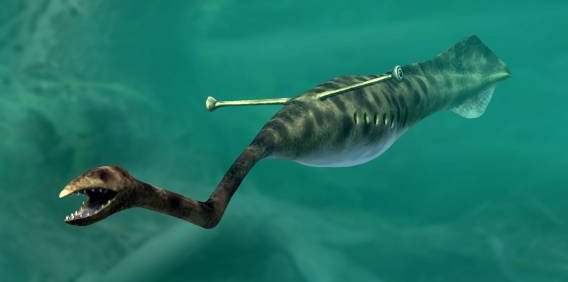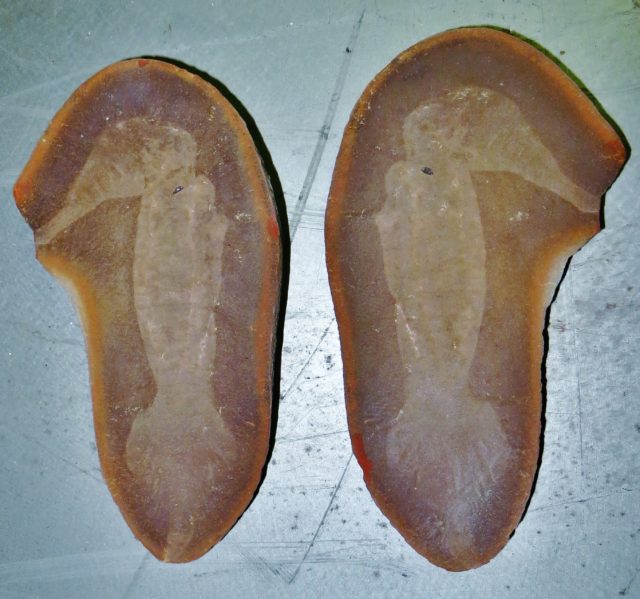
Photo credit: PaleoEquii / Wikimedia Commons CC BY-SA 4.0
Long, long, long ago, there was a sea creature that was similar to a cuttlefish… but it was also like a slug, and it also looked like a leech. When a fossil of this strange creature was discovered hundreds of millions of years later, it was named after its discoverer and called the “Tully Monster.” Scientists have been unable to agree on how the creature should be classified, shrouding the specimen in mystery.
Discovery of the Tully Monster

The Tullimonstrum gregarium. (Photo credit: Nobu Tamura / Wikimedia Commons CC BY-SA 4.0 / cropped)
The scientific name of the unclassifiable specimen is Tullimonstrum. The discovery of the creature was first made in 1958 when fossil collector Francis Tully noticed it in the Mazon Creek fossil beds, located in Illinois. The particular fossil Tully found dates back to 307 million years ago.
Looking at the Tully monster, it is reasonable to say that it resembles a slug. In the middle of its body, what are thought to be eyes protrude on two stalks, like those of a slug. However, where one might assume the mouth would be located, there is a long, thin appendage with a claw at its end. This claw appears to have teeth.
The Tully monster’s strange features make it difficult to classify it as a vertebrate or invertebrate. As a reminder, a vertebrate is a creature with a backbone. Mammals, fish, birds, and reptiles are vertebrates. Invertebrates are creatures without backbones, such as insects, octopuses, and crustaceans.
A 2016 study classified it as a vertebrate

A T. gregarium, or Tully monster, fossil. (Photo credit: Ghedoghedo / Wikimedia Commons CC BY-SA 3.0)
In 2016, a group of scientists conducted a study and said that the Tully monster had finally been classified. Their evidence suggested that it was, in fact, a vertebrate. The study focused on prominent features of the creature’s physical form. By looking at the fossil, the researchers claimed that there was a notochord in the Tully monster.
A notochord is a flexible rod that runs along the body. Although it is not considered to be a spinal cord, it is considered to be the precursor to a spinal cord. So, the presence of the notochord suggested to these scientists that the Tully monster is best classified as a vertebrate. In this way, they compared it to the same group as lampreys.
The study also looked at pigment granules located in the eyes known as melanosomes. When analyzing them, the scientists noticed that the shape and size were similar to those found in the eyes of other vertebrates, placing it again under that classification.
A more recent study challenges this classification.

3D model of Tullimonstrum gregarium as a vertebrate. (Photo credit: Peter Menshikov / Wikimedia Commons CC BY-SA 4.0)
For a time, the 2016 study was accepted as the closest scientists were going to get to a definitive classification of the Tully monster. However, a more recent study has called into question the 2016 result and brought the mystery of the Tully monster back into the scientific discourse.
This most recent study also looked at melanosomes in the eyes. The researchers used a particle accelerator, called a synchrotron radiation light source, to gain deeper insight into the chemical makeup of melanosomes in fossil samples of Tully monsters and living vertebrates and invertebrates. The particle accelerator supercharges the sample with intense bursts of radiation that cause the elements inside to become identifiable. Each of the elements has its own specific X-ray signature.
By analyzing the zinc-to-copper ratio of the Tully monster’s eye, it was determined that the creature is more like invertebrates than vertebrates, contrary to the previous study’s claims. The Tully monster’s eyes were also found to contain a different type of copper than vertebrates. What’s especially interesting is that, although this unusual creature is different from vertebrates, it is also not identical to invertebrates.
The latest study supports the idea that the Tully monster is not a vertebrate, but at the same time does not support the idea that it is an invertebrate. It seems that scientists are back to square one with the Tully monster, and the mystery continues.





